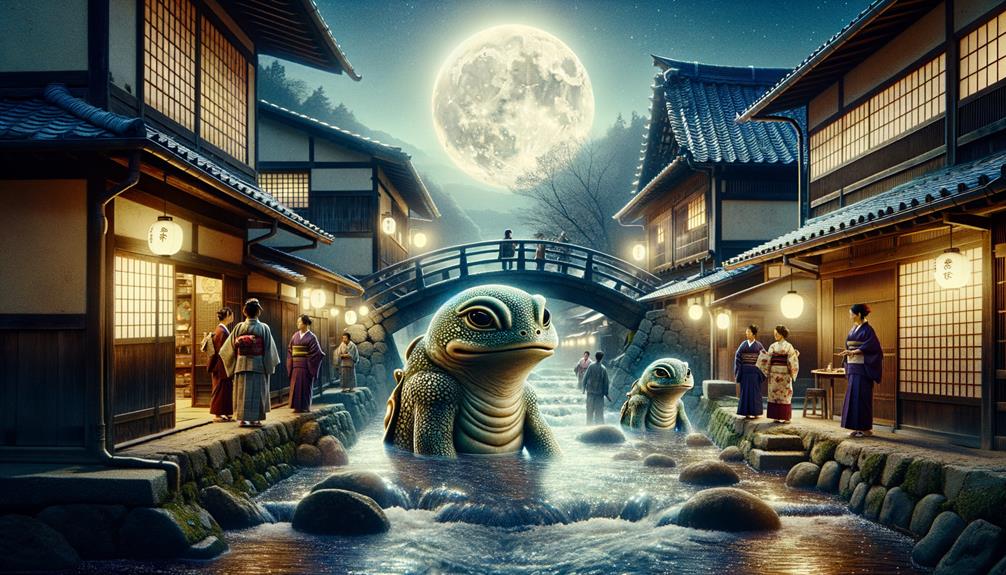Let's take a journey into the peaceful world of Japan's calm ponds and rivers. Hidden beneath the serene surface is the Kappa, a creature that is both charming and eerie. This paradox is an intriguing aspect of Japanese folklore that beckons for a closer look. The Kappa is an aquatic spirit known for its mischievous tricks and menacing acts. This dual-natured creature is not just a product of a vivid imagination, but it also symbolizes the deep cultural and societal layers that have been part of Japan's heritage for ages.
The Kappa has unique traits that make it an enigma. It has a hollow on its head filled with water and an unusual fondness for courtesy. These features are quite the contrast to the harmful actions it's known for. Examining the Kappa isn't just about unraveling a mystery, but also understanding the underlying social and cultural teachings it represents.
As we continue, I encourage you to join me in not just learning about the Kappa, but also in understanding the deeper meanings behind this legendary creature.
The Enigmatic Kappa: Origins

Let's take a trip back to ancient Japan and get to know the mysterious Kappa. This creature, half-human and half-amphibian, pops up in the oldest Japanese stories. It's known for its playful nature and impressive powers. The Kappa is a product of local beliefs and Chinese tales, and it has managed to secure a firm spot in Japanese tradition and thought.
Imagine a creature with a body covered in scales, hands and feet that are webbed, and a back that looks like a shell. That's a Kappa for you! These creatures are said to live in rivers, lakes, and ponds. But it's more than just a water dweller; it's a representation of the mix of fear, respect, and interest that we feel when we look at these water bodies.
Kappas are celebrated for their great strength, their power over water, and their ability to heal, as shown in many Kappa stories. These special traits make the Kappa more than just a character in a story; it's a symbol of Japanese tradition. The part that the Kappa plays in shaping Japanese tales is undeniable. Its influence doesn't stop at stories; it also contributes to Japan's cultural character.
Kappa's Unique Physical Features
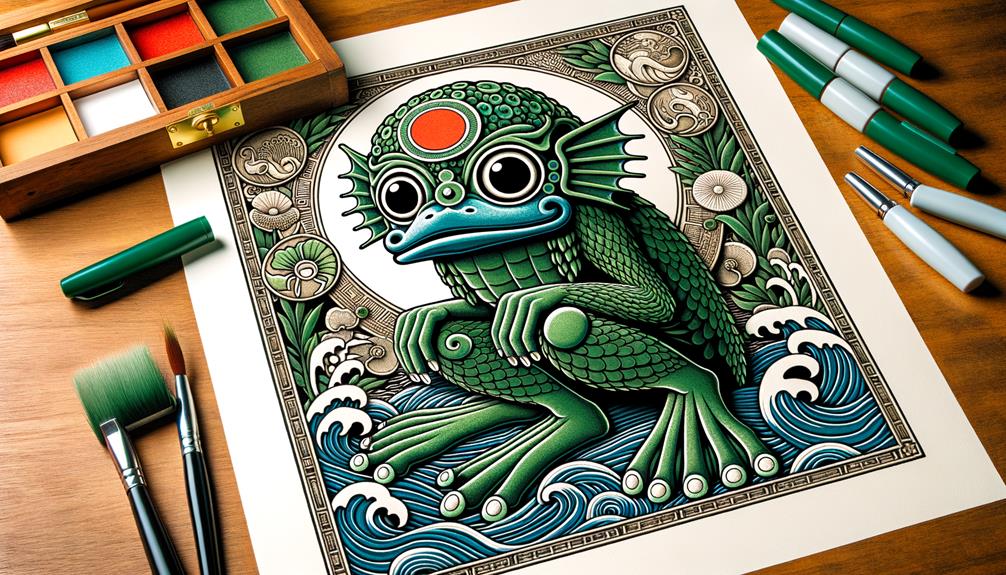
Let's dive into a chatty and friendly chat about the Kappa's unique physical features. These features are not merely interesting to look at, but they are also key to the Kappa's abilities and interactions within its mythology.
- What jumps out first about the Kappa is its striking blue skin. This isn't a smooth skin, but a scaly one. It suggests that the Kappa spends time both in and out of water. Could the eye-catching blue color be a nod to its aquatic lifestyle? We can only speculate.
- The Kappa's head is an intriguing sight with a bowl-shaped dip filled with water. This isn't just a quirky physical trait but a symbol of its life force. If the water spills, the Kappa becomes drastically weakened.
- The Kappa's hands and feet are webbed, which comes in handy for swift and efficient movement through water. These webbed limbs, along with a protective shell-like structure on their back, make the Kappa well-suited to an aquatic lifestyle.
- The Kappa's beak-like mouth is a clear indication of its predatory nature, built for catching prey.
These physical traits don't just determine how the Kappa looks. They also influence its behaviors, abilities, and its place within the mythology. This adds a whole new layer of intrigue to this captivating creature.
Cultural Significance of Kappa
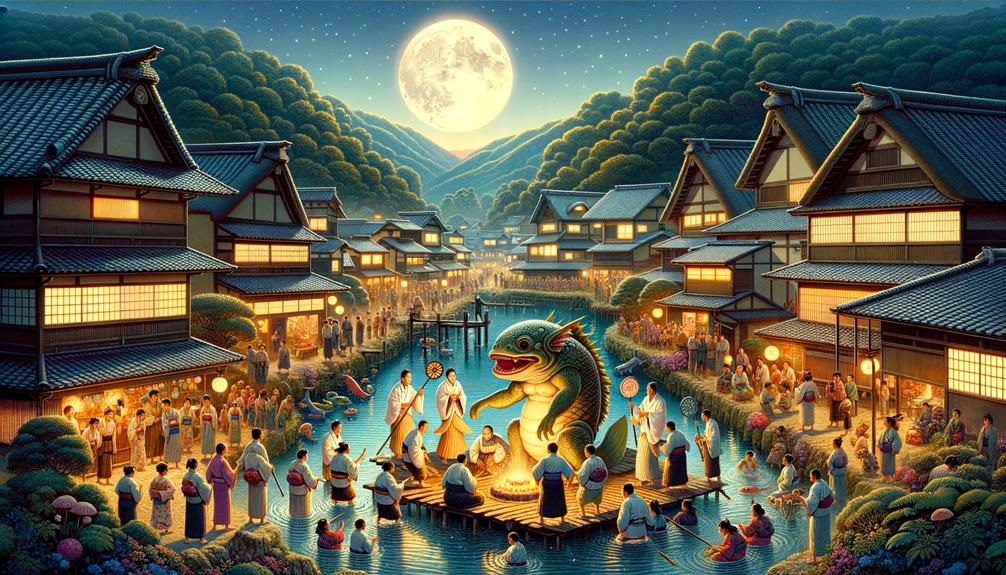
The Kappa, through its intriguing physical features, holds a special place in Japanese culture and mythology. This creature's importance stretches from ancient times to modern day Japan, providing us with a unique perspective into Japan's heritage and identity.
Known as a central figure in Japanese folklore, the Kappa has inspired countless fascinating stories that continue to charm us all. This creature's deep connection with Japanese culture gives us a chance to understand societal norms and values better. Its presence in various forms of art, literature, and pop culture emphasizes its ongoing relevance and has become a symbol of local pride and heritage.
The Kappa isn't just seen in books, video games, or anime. It's also found its way into real-life places, becoming a symbol of identity for local communities. For instance, the town of Mizuki in Tottori Prefecture uses its association with the Kappa to attract tourists, transforming it into a popular destination. This shows that the Kappa's cultural importance goes beyond just entertainment or folklore; it's a reflection of deep-seated societal norms and values.
Getting to know the Kappa folklore helps us understand how deeply embedded this creature is in the cultural psyche of Japan. Every story offers us a chance to learn more about the vibrant and rich culture of Japan.
Kappa's Presence in Modern Japan
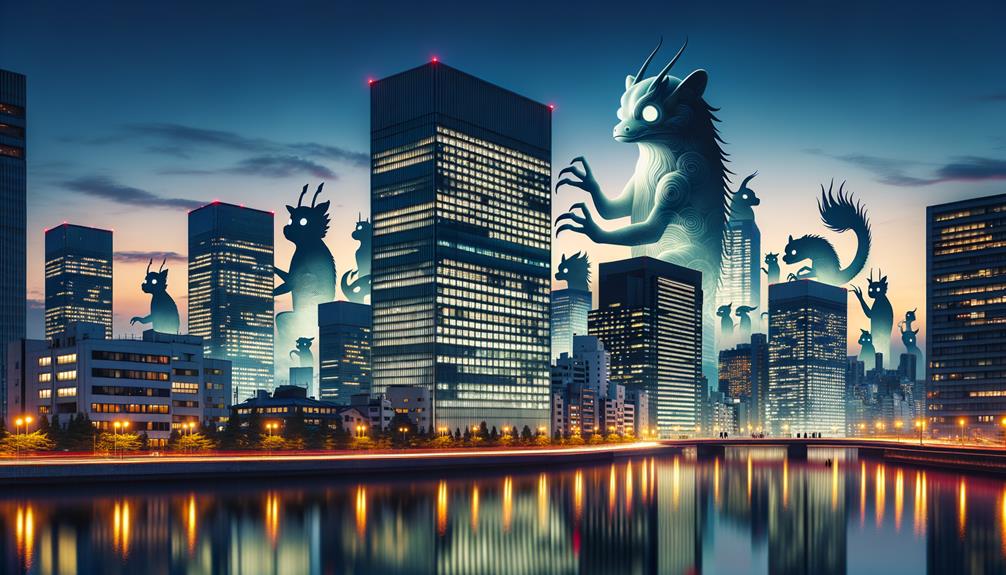
The Kappa's impact on contemporary Japan is more than a nod to past folklore. It's alive and kicking, visible across various art forms, literature, and the pop culture scene. This mythical creature from yesteryears has managed to stay relevant even in today's fast-paced society, with its charm still captivating the masses.
- Take a look at any art exhibition, watch a trendy anime, or get lost in a video game, and chances are, you'll come across a Kappa. It's a popular character that has found its way into mainstream media.
- The Kappa stories are so famous in the town of Mizuki that it's become a must-visit for tourists. This just goes to show how much people still value these ancient folktales.
- There's always a sense of thrill and curiosity when you hear about a Kappa sighting near a river or lake in a rural area. It adds a dash of mystery to the everyday life.
- Certain physical traits of the Kappa, like the hollow on its head or its love for cucumbers, have become iconic symbols in Japanese culture.
In short, the Kappa is not a forgotten tale from the past. Instead, it's a part of Japan's cultural scene today. The folklore keeps changing with the times, ensuring that the Kappa remains a significant cultural emblem.
Kappa-related Locations Exploration
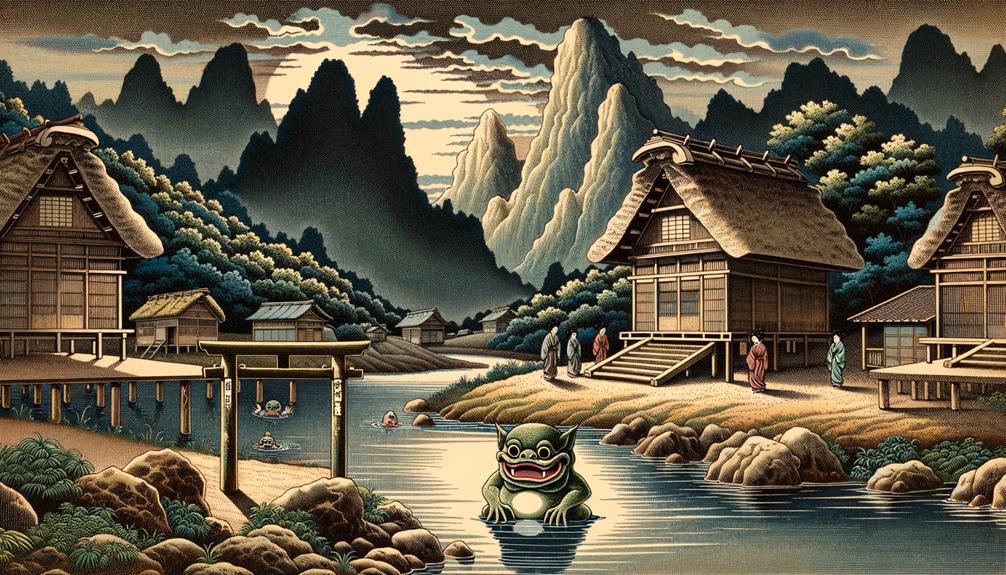
Venturing into the heart of Japan's Kappa-related locations gives you a real taste of the rich folklore and mythology surrounding these mysterious water creatures. They're known to hang around water bodies like rivers, lakes, and ponds, most often in the country's rural areas.
These areas of Japan have a reputation for Kappa sightings, and visiting them offers a wealth of knowledge about Kappa folklore. What I find really interesting is how the attributes and behaviours assigned to Kappa can change so much from one place to the next. This variation between regions adds an extra layer of depth to the mythology, highlighting the role of Kappa in different cultural communities.
Even today, there are stories of Kappa sightings, and it's exciting to think you might spot one while visiting these places. Regardless of whether you believe in the existence of Kappa or not, visiting these Kappa-related locations allows you to delve deeper into this captivating part of Japanese folklore. Each trip gives you a chance to appreciate the vibrant mix of stories, beliefs, and traditions that continue to shape Japan's cultural scene.
Frequently Asked Questions
What Are the Mythical Facts About Kappa?
You know what's fascinating? Kappa. These creatures from Japanese mythology are such intriguing characters. Picture them as playful spirits who hang out by rivers, usually up to no good. But they're not your typical spirits – they're often depicted as humanoid reptiles. One of the most unique things about them is this water-filled dip on their heads. It's not just for show, though. This little pool is actually the source of their power and supernatural skills. Cool, right?
What Does the Kappa Symbolize?
The Kappa, in my view, symbolizes the two sides of nature. It's kind of like a trickster, but with a healing touch too. This shows how the natural world can be a mixed bag – sometimes it might feel like it's playing tricks on you, but other times it can be a source of healing and wellness. So, the Kappa kind of serves as a symbol of this natural contradiction we often see in the world around us.
What Are Kappas Known For?
You know, Kappas are quite the characters, especially famous for their cheeky antics involving us humans. These creatures have a deep connection with water and are known to exhibit fascinating abilities, such as controlling water or morphing their appearance. Their distinctive features are often the spotlight of folk stories. In Japan, people hold Kappas in high cultural regard.
What Is a Kappas Weakness?
The Achilles heel of a Kappa, you ask? Well, it's all about the water-filled cavity on their head. You see, if that water spills out or drains away, they turn into sitting ducks – weak and easily taken down. This peculiar trait has a big impact on how Kappas are depicted in movies, books, and other media.

